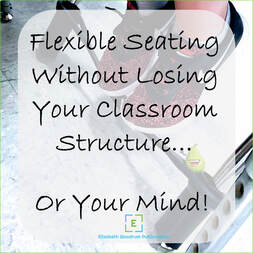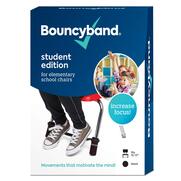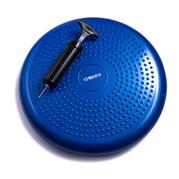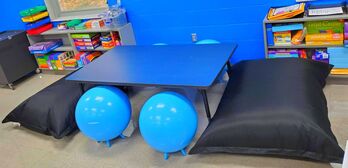 It's Monday morning and you have just started a lesson that you put a lot of time and energy into perfecting. Well, let's be honest. It's probably not perfect, but it's Monday morning and it's still going to be a learning opportunity for your students. Then you start hearing a pencil tapping from your most wiggly student. You glance over and see him dancing in his seat. You briefly wonder if your "perfect" lesson is not as engaging as you thought it was. Mr. Wiggles starts kicking his feet forwards and backwards, adding a nice sound effect to his performance. He abruptly stands up and you wonder if he's about to break into a dance routine. But, no, he's just getting one of the squishy cushions you keep stored at the back of the classroom. He sits back down and silently wiggles on the cushion. There are no more sound effects and Mr. Wiggles is back to focusing on his work. Flexible seating options for the win! The trend of flexible seating created a lot of buzz for quite a while. At this point, most teachers who were interested in trying it out already have. Those who were not interested have probably forgotten about it. There were some who went all in and removed all of their desks, tables, and chairs in favor of couches and recliners. Those who made the change also were likely to give students the freedom to move about the room whenever they wanted. The term is "flexible" seating, after all. Personally, I liked some of the ideas involved with flexible seating. But, I am a bit of a control freak. I embrace that personality quirk and I think it makes my classroom run smoothly. However, I also teach sixth-graders, who are full of energy. I have never minded the bouncy behavior of kids at this age, but it often creates noise and distractions for others. So, I went into the idea of flexible seating knowing that I wanted to give students options to channel their energy. I did not want to sacrifice my classroom structure because I knew that would drive me crazy. So, I took more of a middle-ground approach that I have been perfecting for the last few years. Why Flexible Seating?To be honest, I never researched flexible seating in particular. But, the trend became popular, or maybe I just happened to catch wind of it, at about the same time I moved to teaching sixth-grade from fourth- grade six years ago. My first year in sixth-grade, I didn't do any sort of flexible seating. But, I noticed the kids were extra bouncy compared to the fourth-graders I had just spent nine years teaching. I even had a few who I told they could stand at the back of the room along a counter top, if they wanted. Their focus improved greatly. It was then that I knew I needed to do something, but I wasn't sure what. Then, I attended a workshop based on the research based methods in the Teaching with Love & Logic book by Jim Fay and Charles Fay. While the workshop is focused on behavior management, one of the ideas presented, giving students options as a way to decrease negative behaviors, seemed to fit well with flexible seating. Since I was planning on implementing a lot of the strategies I learned at that workshop into my classroom, I decided to give flexible seating a try. Students are told what to do on a daily basis by all of the adults in their lives. Giving students a chance to make their own choices during the day, even the simple choice of customizing their seating arrangements, can give them the feeling of control in their day. It's also a chance to practice their decision making skills. All of this can lead to a smaller likelihood that those kids with a high-need for control (often due to a lack of control over anything at home, especially if they have a poor home life) will try to take control in other aspects of the classroom. When students enter the classroom and immediately get to make a choice, their needs for control and feeling like they have some say in their own lives can be met. To me, flexible seating seemed like an easy way to give kids some control in a way that doesn't affect the control I still need in order to run an efficient classroom. StrategyAs I said, I went with more of a middle-ground approach. I've adjusted it some in the last few years, but the main concepts have stayed the same. Students have assigned seats in groups in my classroom. But, every day, they technically have three options. 1. Choose to keep the standard desk and chair as is 2. Choose a chair with a bouncy band 3. Choose a seat cushion In my school, sixth-graders rotate through three teachers a day. So, each day, when they come into my rotation, they have a few minutes to get organized. They get their Chromebook from the cart, write down their word of the day, read the tasks for the day to get their materials ready, and adjust their desk space, if they choose. I have ten bouncy bands and ten seat cushions. You can see the ones I got from Amazon (through a Donors Choose project) at the affiliate links below. My rule is that students can have one or the other, but not both at the same time. Since I have twenty items total, and a class usually consists of about twenty students, there's enough to go around for those who want them. While getting settled for the day, students can rearrange the chairs if needed so that they either have or do not have a bouncy band. They just cannot move a chair to get a bouncy band if someone else has already chosen it for the class period. They could also choose a cushion. They get into a routine pretty quickly. But, I do encourage all students to try out both options at the start of the year. They usually realize their preferences early on. Part of the flexibility here is that I do also allow them to get up to change their option during class without getting permission, as long as it doesn't become a habit. For example, if a student decides she wants a cushion half-way through class, she could get up and get one quietly on her own. After the first week or so, a student making a change during class is rare. The bouncy bands I chose were for chairs. There is an option available for desks, but I did not want to have particular students who happened to sit at those desks be the only ones who could use them and I didn't want to give students the options of changing desks if they wanted the bouncy band. Plus, I worried that the desks, not being weighed down by students, might move more as students used the bands. The bands I got lasted about 3 years and then began slowly snapping in half so cleanly that it looked like they had been cut. If I hadn't seen it happen with my own eyes, I would have started asking some questions about who had been cutting them! But, mine do get a lot of daily use. I did notice some kids will slide the bands all the way up the chair legs if they sit at a desk with a chair that has one and they don't want it. That's part of the reason I encourage students to arrange themselves before class starts. Sliding the bands up higher on the chair stretches the bands out wider than necessary and I'm sure it doesn't help with the lifespan. So, I've replaced all ten at this point, but I replaced one or two at a time. I then did a Donors Choose project to get back up to ten. If you get the bouncy bands, you will want some help when putting them on the chairs. When they are new, they are very tight. I laid the chairs down, with the backrest on the floor, and stepped on one of the legs touching the floor to hold it down. I put one of the plastic cuffs about half-way on the front leg closest to me and then had a partner stretch the band to put the other cuff about half way up on the front leg on the other side. Then, it was easy to slip them up into position. I did manage to put them on all by myself the first time, but it was a little bit of a workout with ten! The cushions were easy to inflate and each one comes with it's own hand pump. Those have stayed inflated for a few years and I've not had to re-inflate them. They do seem less popular than the bouncy bands, but a lot of kids do like them. It's nice that they have two different textures, one on each side. One side is a little smoother than the other, but both have a bumpy feel to them. Kids will use them to sit on, but some kids will also squeeze the sides of the cushion as they sit on it rather than do something like tap their fingers on their desks. Using Flexible Seating in Routines
First, your eyes are not deceiving you. The proportions of these items are a bit out of whack. The table has legs that are adjustable and the table has been lowered. The two bean bags are very large. The four balance ball chairs are more normal sized and are 22" in diameter.
Originally, I just wanted a table where kids could sit on the floor or rise up onto their knees and still be able to work at the table. The first year I had a lowered table, I just had some thin mats. The kids liked the low table, and so I re-imagined it. The balance ball chairs are from Lakeshore Learning. I got the larger size of the 22" seat. They may not look like they'll hold sixth-graders, but they do. I can sit on them comfortably as well. The bean bags are Big Joe brand and I got them from Amazon. You can see them here at this affiliate link. They are big enough that two sixth graders can sit side by side to work at the table. If you end up using these bean bags, I have a few pieces of advice. First, have them delivered to your school if you can. Or, at least leave them in the boxes to transport. They are very light, of course. But, they are enormous! It's hard to imagine how big they are when they arrive in the tall, skinny boxes that mine came in. But, when they are unfurled, they are large in every sense of the word. It was tricky getting them in my car. You will also eventually need to add beans. They will get pretty flat throughout the year. Trust me and get the Big Joe brand to refill. They really do last longer. I got a cheaper brand one year and ended up buying the Big Joe brand to refill half-way through the year. I've used about two bags of the Big Joe refill beans per bean bag to refill at the start of each year and they last all year that way. The refill beans I use can be seen at the affiliate link here. So, how do I use this set up as part of flexible seating? Whenever we read an anchor text that we will be analyzing for a class period or two, we do a "buddy read." I randomly assign buddies by using the group maker tool on Class Dojo. Of course, you could buddy up your students however you wish, if you decide you want to use this method yourself. But, the Class Dojo group maker is very quick. My classroom is set up with 5 groups of desks with 5 desks each, though most groups only have 4 students. So, each time we do a buddy read, I rotate which group gets "first dibs" at the "blue table." Students who sit at that group of desks, and their buddies, may choose to sit at the blue table, if they want. If there are open spaces, then others can fill in. Then, I allow all of the other student pairs, or buddies, to choose where they would like to sit around the room. They can sit at different desks, for example. Some sit at my U-shaped table and some choose to stand at the counter that is part of my built in shelf and cabinet storage area. Whenever we have a buddy read situation, which is about once a week, I use this type of flexible seating. I also use it when we are reading a class novel because students get a random buddy each day when we are reading novels as well. It's part of our regular routine and it's pretty common for me to hear a student or two say, "Oh, we have a buddy read! Whose turn is it for the blue table?" when they see there is a buddy read on the agenda for the day. I enjoy having this type of flexible seating in my class. It allows students choice, but it also is part or our routine. So, it's not really any work for me, once it is set up. It is a preemptive strategy for curbing distracting behaviors because it is helping students learn how to manage their extra energy on their own. Some students learn that a bouncy band really helps them focus and others learn the band itself is an actual distraction. The students learn what works and what doesn't work for their own needs. I'm not suggesting what students need or telling them what to do. It's all up to them. If you are interested in trying flexible seating and haven't yet, perhaps because you are worried about turning your classroom upside down and losing your sanity, consider a smaller scale change. You could start with one little change and adjust or add more changes each year as you see what you like. There are added benefits that I didn't consider when I started adding flexible seating options to my classroom. I haven't found flexible seating to be troublesome at all. In fact, it really helps my classroom run more smoothly.
0 Comments
Leave a Reply. |
Elizabeth Woodrum's Blog
Author of AboutElizabeth Woodrum is the author of the children's book series, The Maisy Files. She is also a full-time teacher and creator of teaching materials that can be found on Teachers Pay Teachers. This blog is a mix of teaching and author topics. Categories |



